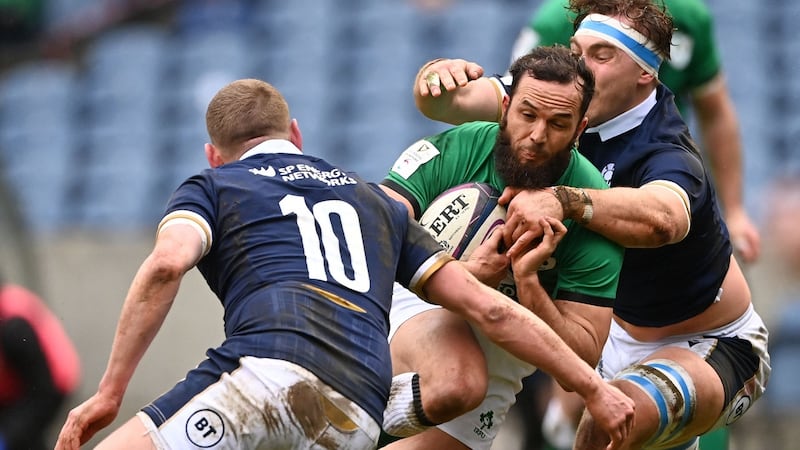Irish scrumhalf James Gibson-Park box kicked at least 13 times against Scotland. There are two trains of thought about high kicks. One is that it is giving the ball back to the opposition unless Irish runners successfully contest in the air. The other is that the territory gained becomes an asset anyway, whether the Irish players - and that was mostly Keith Earls and Robbie Henshaw - make a contest out of it and either force an error or take clean possession themselves.
Earls can be said to have had a strong game on the wing, a lot of it coming from pressure applied under the high ball. Three minutes from the end of the match it was Earls who successfully took the Gibson-Park hoist just after Johnny Sexton had kicked what would be the winning penalty for Ireland.
The question is whether Gibson-Park did enough to keep Conor Murray sitting on the bench next week against England. The fact that Andy Farrell left him on for the entire match is an indication that the coach liked what he was seeing from his nine.
One of the issues Farrell will factor in when he is making his selection later this week is Murray’s physical advantage over Gibson-Park. The Munster scrumhalf stands over six feet and that will be an asset when facing an incredibly physical England side in the final game.
The opening phases and closing phases of the match were stark in contrast in the way Gibson-Park played the ball. He began by forcing a high tempo, which he is good at doing. To play that kind of game also depends on the pack hitting fast and hard in order to make the ball immediately available. It was and Gibson-Park was quick to the break down and crisply with the passing, although Ronan O’Gara at halftime didn’t think so.
First try
The ball in hand, phased play led to Sexton’s first penalty for 0-3 and then five minutes later Gibson-Park’s pass deep to Sexton allowed the outhalf to cross field kick to a chasing Earls. The Munster winger caused enough chaos to delay Stuart Hogg’s reaction and buy just enough time for Henshaw, who was smart on his support run, to score Ireland’s first try.
Jonny Gray was on the edge off offside for a lot of the time trying to pressurise Gibson-Park, who really only took on the ball himself twice during the match. The first on 20 minutes was the wrong call.
The Irish maul were rolling towards the Scottish line and moving forward. Instead of waiting for it to develop or call in a bigger unit he took the ball out of the maul and sniped for the line. But he was snaffled up by the Scottish defence and the offensive move died.

Most of the box kicking went to Earls’s side of the pitch and away from fullback Hogg, which was a clever ploy. On 32 minutes Earls got to it in the air and successfully contested. Tadhg Beirne, up in support, came in and Ireland won a penalty for Sexton to kick for 10-11.
But some of Gibson-Park’s box kicking simply wasn’t deep enough. While it didn’t hurt Ireland too much, it was no advantage. Then in the second half and deep in the match the passing game again briefly came into play.
What that exposed was Ireland’s inability to get much beyond the gain line with ball in hand. Better to look at, the plays went left and right with no significant yardage gain and highlighted Ireland’s lack of penetration.
By the end Gibson-Park had reverted to kicking again as Ireland decided to hold their lead. In the last three minutes he kicked it three times. Farrell’s words after the match shines some light on that. An alternative thought was to hold possession and go through the phases. “Shove it up the jumper,” said former flanker Shane Jennings afterwards.
“In the last two minutes I thought we defended marvellously,” said the Irish coach. “There are lads hanging on in there limb wise as far as injuries are concerned. There was two or three of them that were struggling a little bit but dug in for the shirt.”
Gibson-Park wasn’t sparkling. But he played a solid match which Ireland won. If the physical question can be taken out of the equation, and it can’t, there is no reason to drop the New Zealand born 29-year-old. And Murray, he will kick the ball too.












